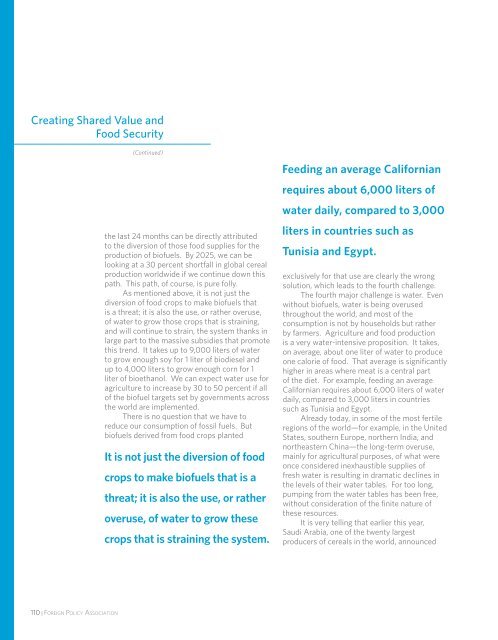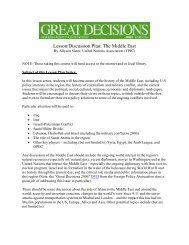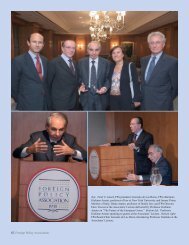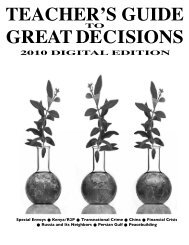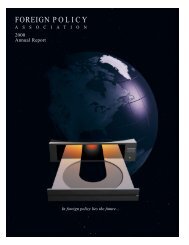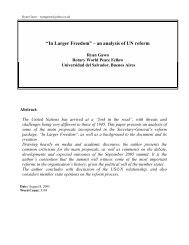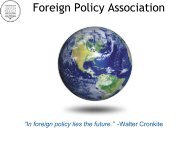Celebrating 90 Years - Foreign Policy Association
Celebrating 90 Years - Foreign Policy Association
Celebrating 90 Years - Foreign Policy Association
Create successful ePaper yourself
Turn your PDF publications into a flip-book with our unique Google optimized e-Paper software.
Creating Shared Value and<br />
Food Security<br />
110 | FOREIGN POLICY ASSOCIATION<br />
(Continued)<br />
the last 24 months can be directly attributed<br />
to the diversion of those food supplies for the<br />
production of biofuels. By 2025, we can be<br />
looking at a 30 percent shortfall in global cereal<br />
production worldwide if we continue down this<br />
path. This path, of course, is pure folly.<br />
As mentioned above, it is not just the<br />
diversion of food crops to make biofuels that<br />
is a threat; it is also the use, or rather overuse,<br />
of water to grow those crops that is straining,<br />
and will continue to strain, the system thanks in<br />
large part to the massive subsidies that promote<br />
this trend. It takes up to 9,000 liters of water<br />
to grow enough soy for 1 liter of biodiesel and<br />
up to 4,000 liters to grow enough corn for 1<br />
liter of bioethanol. We can expect water use for<br />
agriculture to increase by 30 to 50 percent if all<br />
of the biofuel targets set by governments across<br />
the world are implemented.<br />
There is no question that we have to<br />
reduce our consumption of fossil fuels. But<br />
biofuels derived from food crops planted<br />
It is not just the diversion of food<br />
crops to make biofuels that is a<br />
threat; it is also the use, or rather<br />
overuse, of water to grow these<br />
crops that is straining the system.<br />
Feeding an average Californian<br />
requires about 6,000 liters of<br />
water daily, compared to 3,000<br />
liters in countries such as<br />
Tunisia and Egypt.<br />
exclusively for that use are clearly the wrong<br />
solution, which leads to the fourth challenge.<br />
The fourth major challenge is water. Even<br />
without biofuels, water is being overused<br />
throughout the world, and most of the<br />
consumption is not by households but rather<br />
by farmers. Agriculture and food production<br />
is a very water-intensive proposition. It takes,<br />
on average, about one liter of water to produce<br />
one calorie of food. That average is significantly<br />
higher in areas where meat is a central part<br />
of the diet. For example, feeding an average<br />
Californian requires about 6,000 liters of water<br />
daily, compared to 3,000 liters in countries<br />
such as Tunisia and Egypt.<br />
Already today, in some of the most fertile<br />
regions of the world—for example, in the United<br />
States, southern Europe, northern India, and<br />
northeastern China—the long-term overuse,<br />
mainly for agricultural purposes, of what were<br />
once considered inexhaustible supplies of<br />
fresh water is resulting in dramatic declines in<br />
the levels of their water tables. For too long,<br />
pumping from the water tables has been free,<br />
without consideration of the finite nature of<br />
these resources.<br />
It is very telling that earlier this year,<br />
Saudi Arabia, one of the twenty largest<br />
producers of cereals in the world, announced


